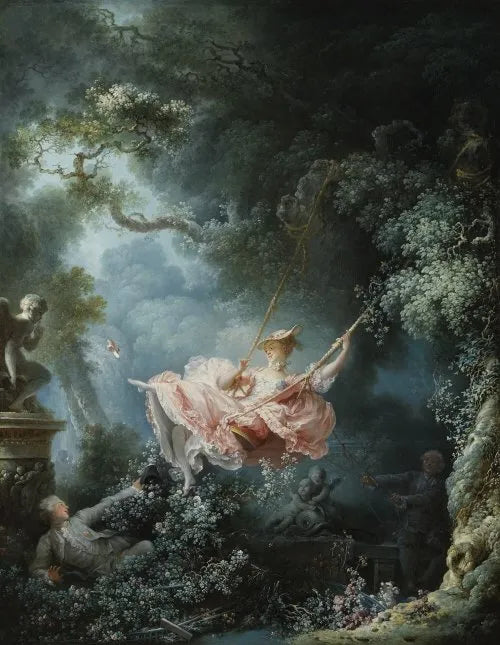Rococo art originated in Paris, France, in the early 18th century. The term Rococo derives from the French word rocaille, which means a shell-covered rock that was used for garden grottoes. After the death of Louis XIV, the French court moved back from Versailles to their homes in Paris and began to move away from the heavy baroque style to softer designs and modest materials. Similar to home decorations, Rococo painting is often shown with softer colors and graceful curves that depict daily life and courtly love. One artist who adapted this style is named Jean-Honoré Fragonard. One of his greatest masterpieces is called The Swing, which centers a carefree young woman enjoying herself on a swing. The piece was described as light-hearted and playful, but at the same time risque and erotic.
Unfortunately, Fragonard was not the first option to paint this piece. The “unnamed gentleman of the court” who commissioned the piece initially approached a French painter named Gabriel François Doyen. Upon hearing the gentleman’s request, Doyen immediately refused to paint the piece, worried that it would harm his reputation as a respectable religious history painter. However, Doyen recommended the gentleman to Fragonard who, at that time, mainly painted for the royalty.
At first glance, the painting looked innocent and playful. The young woman is definitely the center of the viewers’ attention, with her light pink dress and white laces that showcase her carefreeness as the light shines on her. The woman's position indicates her lightness as she glides upward on her swing as her right shoe slips off her foot, showing her childlike playfulness. However, this painting is far from being as innocent as it initially looks.

Down below the woman on the left side of the painting is a man lying on a bush with his left arm outstretched, as if reaching out to her, while looking at her with infatuation. But is he really looking at her or something else? This is where the painting starts to take a not-so-innocent expression. If you follow his gaze, he is looking directly under the woman’s skirt as she glides upward with her swing. At the same time, her ankle is showing, which at the time indicated an erotic gesture.
The unnamed gentleman who commissioned the painting is actually the gentleman who is laying on the bush while his lover is on the swing. As for the older man found on the right side of the painting, pushing the swing for her, he is actually the woman’s husband. He is looking at his wife with pure admiration and is completely oblivious to his wife’s affair.
Despite how beautiful the piece turned out, what makes Fragonard stand out are the little details he added to the painting. First are the reins on the swing that the husband is controlling to swing his lovely young wife. Initially, it looks like he controls the swing, but it's actually symbolism for the woman going back and forth between her lover and husband. At the same time, on the left rein of the swing, you can see that the rope is slowly fraying, which symbolizes her marriage falling apart. Second, the statue of Cupid, who is the god of love, has its index finger to its lips, indicating to the woman that her secret affair is safe in the garden. This statue of Cupid would be easily recognizable as it is inspired by a sculpture created by Etienne-Maurice Falconet for Madame de Pompadour, King Louis XV’s former mistress. Similarly, on the bottom right, close to the husband, are two baby statues called putto. In contrast to the statue of Cupid, the two baby statues looked at the women with shock and shameful eyes, as if showing disapproval toward the woman’s affair. Lastly, a small, white fluffy dog barking at the woman appears on the bottom right side of the painting. Usually, dogs in paintings often symbolize fidelity, however, with the dog barking, it seems like the dog is not pleased with the woman’s infidelity. Overall, even though the painting depicts one wholesome image, the themes of the painting are split in half. The left side of the painting seems to be illustrating the untamed desire of infidelity, while the right side is advocating for fidelity and restraint.
Despite how risque the painting turned out, many people who saw it admired it. An artist named Nicholas Delaunay created a printed version of the painting that helped circulate the piece to fellow Parisian elites. In today’s pop culture, the painting can be seen in popular movies like the animated movie Frozen. While Princess Anna sang the famous song, “Do You Wanna Build a Snowman”, a glimpse of the famous painting appeared as she roamed around the castle feeling bored. Currently, the piece resides as part of The Wallace Collection in the London Art Gallery.
©ArtRKL™️ LLC 2021-2023. All rights reserved. This material may not be published, broadcast, rewritten or redistributed. ArtRKL™️ and its underscore design indicate trademarks of ArtRKL™️ LLC and its subsidiaries.





